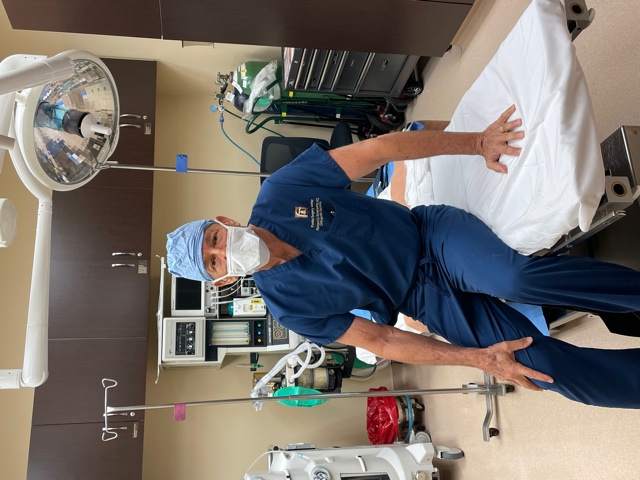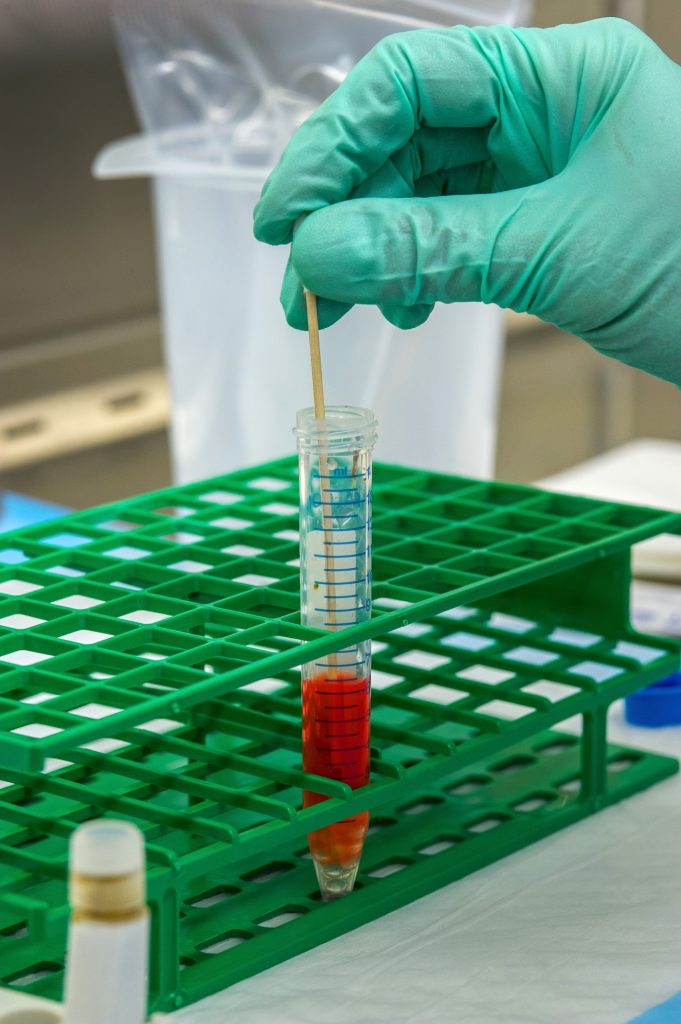To Stem Cell or Not to Stem Cell: A Q&A with an Orthobiologics Expert

There is nothing shy about Richard Scheinberg — he believes orthobiologics is a cutting-edge solution to treat joint and musculoskeletal problems.
The owner of Scheinberg Orthopedic Group at 401 North Chapala knows that anything associated with “stem cell” treatments comes with a stigma but is adamant that orthobiologics utilizes the body’s own stem cells to help avoid the fallout from traditional surgery on shoulders and knees.
“We didn’t really have any way of providing substantial relief other than surgical treatments such as bionic replacement of joints, hip replacements, knee replacement, shoulder replacements, that type of surgical procedure, which are very substantial operations, and that don’t always work perfectly,” Scheinberg said. “So, now we have an option to use your own healing ability, which is your own stem cells to concentrate those stem cells and then re-inject them into areas of the body such as the knee, the shoulder, the back, that traditionally have been treated surgically.”
The Montecito Journal sat down with Scheinberg to chat about orthobiologics, addressing everything from false narratives to what insurance companies will and won’t cover:
Q: What are the advantages of orthobiologics?
A: I’m an orthopedic surgeon. I’ve been doing surgeries for 40 some odd years and been doing joint replacements, surgeries, sports medicine, arthroscopic surgeries, shoulders, knees — all of it. We as orthopedic surgeons see problems that require a surgical solution up until the advent of orthobiologics, which is stem cell biology as well as PRP, which is concentrated in platelet biology. And in many instances, just simply with this type of injection, which we often will do in combination with PRP — which are concentrated platelets — we are able to achieve very similar results we could have achieved with a big operation and avoid the prolonged recuperative healing phase recovery phase that is inherent in any operation.
What about the time it takes to perform the procedure?
An injection such as this from start to finish when the patient comes in as an outpatient usually takes about an hour and a half to two hours before they leave the office and leave the surgery center, and they’re pretty much able to go about their normal activities of daily living after the procedure.
Scientifically, can you be more specific about orthobiologics advantages?
So, there’s two aspects of these injections that are beneficial: One is the very powerful anti-inflammatory effect of the PRP and bone marrow concentrate in combination, but also the long-term regenerative effect for the stem cells. So that sometimes takes as long as three to six to nine months to maximize the results. So, if a patient comes in, for example, who wants a knee replacement or a hip replacement, and they’re trying to avoid the surgery, they will oftentimes get immediate pain relief after three or four days following the injection. But it’s a long-term regenerative effect of six to nine months that we’re really looking for; that allows them to function without need for surgery. Indefinitely.
What are the advantages to stem cell when compared to epidural injections, particularly for back pain?
Traditionally, epidural injections and back injections and pain management are done with steroids. So, if you go to a pain management doctor — and your insurance is going to cover it — they’re going to use steroids on you. They’re going to use cortisone or something of that nature. And steroids are known to be anti-metabolic. They’re good anti-inflammatories, but they are not good for you — particularly if you have diabetes. Utilizing orthobiologics, we use the same material bone marrow concentrate and PRP and strategically inject that into the facet joints and into the areas of arthritis in the back to eliminate back pain and to heal back pain long-term rather than a short-term solution like an epidural steroid injection. Traditional chronic back problems, epidurals are done almost exclusively with steroids. We use orthobiologics to do them, which is a much more homeopathic solution with long-term, good results and without any detrimental steroids that that can cause collateral damage.
You’ve been performing stem cell treatments for eight years now; what is the main concern that patients face?
We’ve done literally hundreds of these now. So, it does entail some expense even though in Santa Barbara where we do our procedures, it’s probably a third to a quarter what they would charge in Beverly Hills and other facilities. The reason is we’re trying to get the word out that there is an alternative to major surgery or dealing with injuries and degenerative conditions such as the arthritis, hip arthritis, shoulder surgeries, rotator cuff repairs, and that sort of thing. So, the issue becomes one and economic one because insurance does not cover it.

But aren’t there practitioners out there using “off-the-shelf” solutions?
Yes, there are some using birth products, amniotic fluid embryonic fluids, Wharton’s jelly things — those types of products as a source of stem cells, when the reality is those aren’t live stem cells and there are no stem cells in those types of products. The only source of stem cells that the FDA really clears is when we use your own stem cells. And we concentrate your own stem cells, which we take from bone marrow, which is the most accessible source of stem cells in your body and provides the highest quality and the highest concentration after we centrifuge it and separate it out in our laboratories.
So, you’re saying there might be some false advertising out there?
One of the problems with people bristling [over stem cell treatment], is that there has been a lot of hype in this marketplace by practitioners who aren’t doing it properly and are misleading the public. So that if it is done properly, if you are using your own stem cells that are derived from concentrated bone marrow, then the results are going to be predictably much better than using a source that doesn’t have live stem cells. And so there has been some misinformation in the public about stem cells. This whole area of medicine and biology is very new in the sense that it’s only been maybe 15 to 20 years that we’ve been utilizing these types of solutions. It’s early on, and we don’t fully understand all the nuances of it — other than subjectively the patients get better and avoid surgeries.
Well, objectively, what do the numbers look like?
We have some idea and certainly the scientists have a very clear idea as to how the stem cells differentiate bone and tissue and soft tissue and cartilage. This is dependent to a great extent on one’s own DNA and our own ability to heal. And so, there are some variations and results. We’re getting 87% good-to-excellent results avoiding surgery, which is very good. And in fact, if you looked at the knee replacements that I or any of the other doctors in town are doing, our results aren’t much better with major surgery and the recovery, as well as trauma of going through it and the hospitalization is so much better.
You’ve dedicated a significant part of your practice to this style of treatment, why?
I’m probably the only orthopedic surgeon who’s doing a lot of these locally because I’ve identified that this was a very productive area of medicine and orthopedics for patients to help them, as well as helping them avoid getting themselves into having complications from surgeries, which we still do. I primarily do surgical procedures, but we’re seeing that the patients who do the orthobiologic procedures do better. They’re grateful because they haven’t gone through a big operation that some other doctor has told them about.
Do other surgeons reject orthobiologics? Is it about the science or the business?
It is totally embraced. We have much more literature on this than we have on many of the orthopedic procedures that are being done, such as arthroscopic meniscectomy and things of that nature. Surgeries are the bread and butter of how orthopedic surgeons make a living, so, there’s an inherent conflict of interest if you will. If I make my living doing the replacements all day long, like several other doctors do in this community and someone saying, “Hey, you may not need a knee replacement and, by the way, 50% or more of the knee replacements being done at Cottage Hospital now could be eliminated with this with a much more simple, less invasive procedure.” Yeah, probably not going to be so happy about that.
Let’s circle back to insurance; what’s the deal on not covering orthobiologics?
The patients are coming in to see us because I don’t have any influence over the insurance lobby one way or the other. Right. And there are workers comp insurances that will cover PRP. They don’t cover bone marrow concentrate. And I don’t know why they wouldn’t pay $7,000 for stem cell injection with PRP, instead of the $40,000 or $50,000 or more for a knee replacement. It just stands to reason that they should embrace orthobiologics, but for some reason they haven’t.





